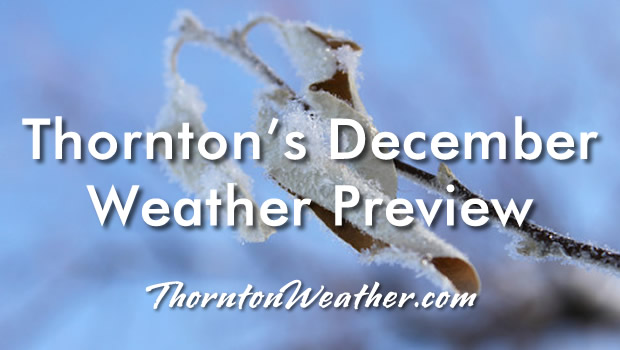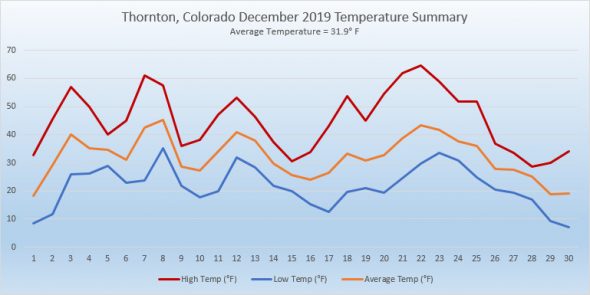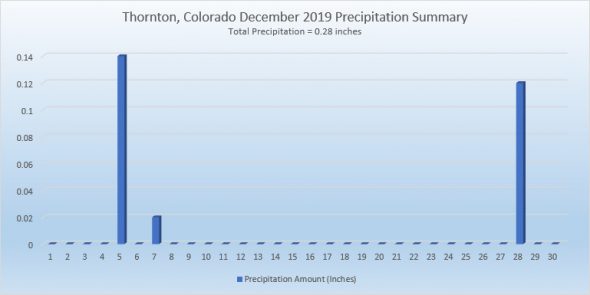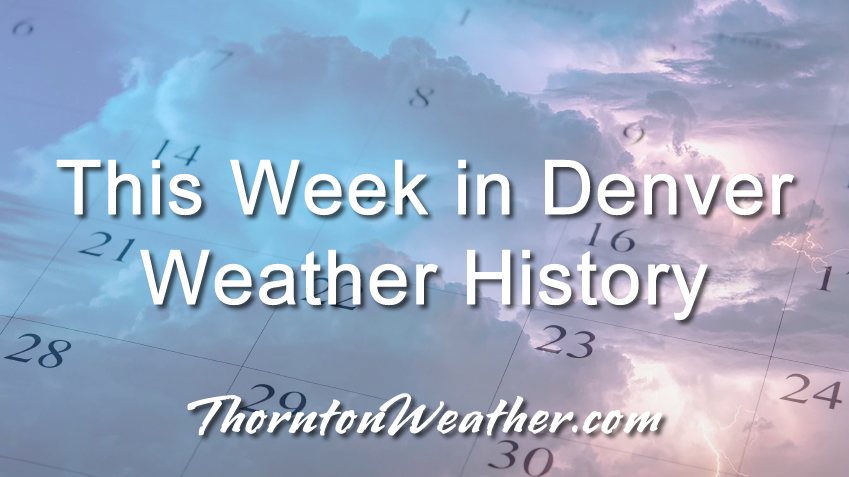December can of course be cold and that is why Chinook winds are sometimes welcomed as they bring warm air to the Front Range. However, those winds can also cause a great deal of damage if they blow too hard and we see that in our look back at this week in Denver weather history. Particularly notable were winds on December 14th & 15th which caused accidents, toppled power poles and fences, ripped off roofs and more.
From the National Weather Service:
2-17
In 1939…more than 2 weeks of unseasonably warm weather made the month the 3rd warmest on record. Seven daily temperature records were set…including the all time record high temperature for the month of 79 degrees on the 5th. Daytime highs were balmy with 14 days in the 60’s and 70’s. Low temperatures dipped to freezing or below on only 5 days. The period was dry with only a trace of snow on the 12th.
3-15
In 1972…a protracted cold spell held an icy grip on metro Denver when maximum temperatures never reached above freezing for 10 consecutive days from the 3rd through the 12th and minimum temperatures dipped below zero on eleven consecutive days from the 5th through the 15th. Daily low temperature records were set with 15 degrees below zero on the 5th…17 degrees below zero on the 6th… And 18 degrees below zero on the 10th. Daily record low maximum readings were set with 3 degrees on the 6th and 6 degrees on the 9th. The very cold temperatures were caused by 3 to 5 inches of snow cover and a Canadian air mass.
9-13
In 1961…cold arctic air produced a protracted cold period. The temperature plunged to 16 degrees below zero on the 10th…establishing a new record for the date and the coldest reading since 25 degrees below zero on February 1… 1951. Low temperatures dipped below zero on 5 consecutive days with 9 degrees below zero on the 9th…16 below on the 10th…10 below on the 11th…and 12 below on both the 12th and 13th. High temperatures reached only 3 degrees on the 10th and 6 degrees on the 11th.
11-13
In 1940…5.4 inches of snow fell across downtown Denver. This was the only snowfall of the month. Temperatures were quite cold on the 13th with a high of 6 degrees and a low of 2 degrees below zero.
In 1984…up to 6 inches of new snow fell over metro Denver… Hampering flight operations at Stapleton International Airport where snowfall totaled 3.8 inches and east winds gusted to 25 mph on the 11th.
12-13
In 1916…snowfall totaled 5.7 inches in downtown Denver. Northeast winds were sustained to 27 mph with gusts to 28 mph on the 12th.
In 1992…an upslope snowstorm whitened metro Denver. While snowfall totaled only 4.1 inches at Stapleton International Airport…7 inches of new snow fell in Morrison…with 12 inches measured in Castle Rock. North winds gusted to 23 mph at Stapleton International Airport on the 13th.
In 1995…strong winds gusting to nearly 100 mph whipped across the foothills west of Denver. The strongest wind gusts included 98 mph atop Squaw Mountain and 75 mph at the Eldora Ski Area. West-northwest winds gusted to 41 mph at Denver International Airport on the 13th.
12-15
In 1921…downslope Chinook winds produced warm temperatures in the city…which resulted in 4 temperature records. High temperatures of 72 degrees on the 13th and 68 degrees on the 15th were record maximums for the dates. Low temperatures of 47 degrees on both the 12th and 13th were record high minimums for the dates. West winds were sustained to 38 mph on the 12th and to 25 mph on the 13th.
13
In 1955…strong winds raked the foothills. A wind gust to 72 mph was recorded at rocky flats northwest of Denver. Some damage occurred in Boulder. Northwest winds were sustained to speeds of 23 mph at Stapleton Airport.
In 1988…high winds again occurred in Boulder where winds were clocked to 66 mph. West winds gusted to 43 mph at Stapleton International Airport.
13-14 in 1902…heavy snowfall totaled 6.4 inches in the city overnight. North winds were sustained to 18 mph with gusts to 20 mph on the 13th.
In 1925…heavy apparent post-frontal snowfall totaled 7.8 inches across downtown Denver. Northwest winds were sustained to 34 mph with gusts to 42 on the 13th… And north winds were sustained to 33 mph with gusts to 38 mph on the 14th.
In 1951…heavy snowfall totaled 5.9 inches at Stapleton Airport.
In 1987…a snowstorm dropped 2 to 8 inches of snow along the Front Range foothills. Eight to 12 inches fell just south of Denver. Icy streets and highways contributed to many traffic accidents across metro Denver and flights were delayed at Stapleton International Airport where 2.7 inches of snow fell and northeast winds gusted to 17 mph.
In 1991…high winds pummeled metro Denver. Wind gusts to 93 mph were recorded at Rollinsville. Wind speeds across metro Denver were generally 35 to 50 mph. Northwest winds gusted to 48 mph at Stapleton International Airport on the 13th.
14
In 1926…an intrusion of cold air resulted in temperatures remaining below zero. The high temperature of one degree below zero was a record low maximum for the date. The low temperature was 11 degrees below zero. North winds were sustained to 17 mph.
In 1985…a wind gust to 61 mph was recorded at Table Mesa in Boulder.
In 1996…high winds gusting from 60 to nearly 80 mph moved off the Front Range foothills and over the northeast Colorado plains in the wake of a fast moving cold front. The strongest wind gusts included 79 mph at Golden gate canyon and 70 mph near Table Mesa in southwest Boulder. At Denver International Airport…west-northwest winds gusted to only 39 mph.
14-15
In 1988…a snow storm again whitened metro Denver. Snowfall along the Front Range was in the 6 to 12 inch range. Snowfall totaled 5.8 inches at Stapleton International Airport where north winds gusted to 38 mph.
In 1990…high winds howled across metro Denver behind a strong pacific cold front. Boulder was hardest hit by the high winds. A wind gust to 120 mph was recorded in south Boulder where winds stripped the roof off a garage…a vacant gas station…and a house under construction. Elsewhere in Boulder…several trees were blown down. In Boulder canyon…the winds toppled two cinder block walls on a house under construction. Four Boulder County women were treated for injuries caused by the wind. The injuries were confined to a broken wrist…a mild concussion…bruises…and facial cuts. Two semi-tractor trailers were blown over by the fierce winds south of Boulder. Another truck rollover occurred southeast of Golden. Drivers of all three trucks suffered only cuts and bruises. Several vehicles were trapped in a blinding dust storm on the Denver-Boulder Turnpike near Broomfield. Drivers were forced to stop along the highway for several minutes during the storm and witness their vehicles being pelted with sand and gravel. A wind gust to 97 mph was recorded in Golden. High winds were also reported in Arvada…Boulder…and Lakewood. Winds toppled a number of utility poles and wooden fences…blew out windows…and caused structural damage to a large apartment complex on the west side of Golden. Wind gusts of 70 to 100 mph caused considerable damage to several large billboards north of Golden…as well as damaging the paint…trim…and glass on numerous vehicles in the area. A west wind gust to 51 mph was recorded at Stapleton International Airport.
15
In 1999…high winds developed in and near the foothills as a strong upper level jet moved into the area. Although most wind gusts were in the 70 to 80 mph range…a weather spotter located 1 mile south of Fritz Peak near Rollinsville measured a peak wind gust to 124 mph. Other wind reports included wind gusts to 77 mph at the National Center for Atmospheric Research in Boulder and atop Blue Mountain and 70 mph at the national wind technology center on Rocky Flats south of Boulder. West winds gusted to only 32 mph at Denver International Airport.
In 2000…high winds developed in the foothills of Boulder County…but winds were strong across all of metro Denver. Winds gusted as high as 72 mph at the National Center for Atmospheric Research on the mesa just southwest of Boulder. West winds gusted to 44 mph at Denver International Airport.
Continue reading December 13 to December 19: This week in Denver weather history






